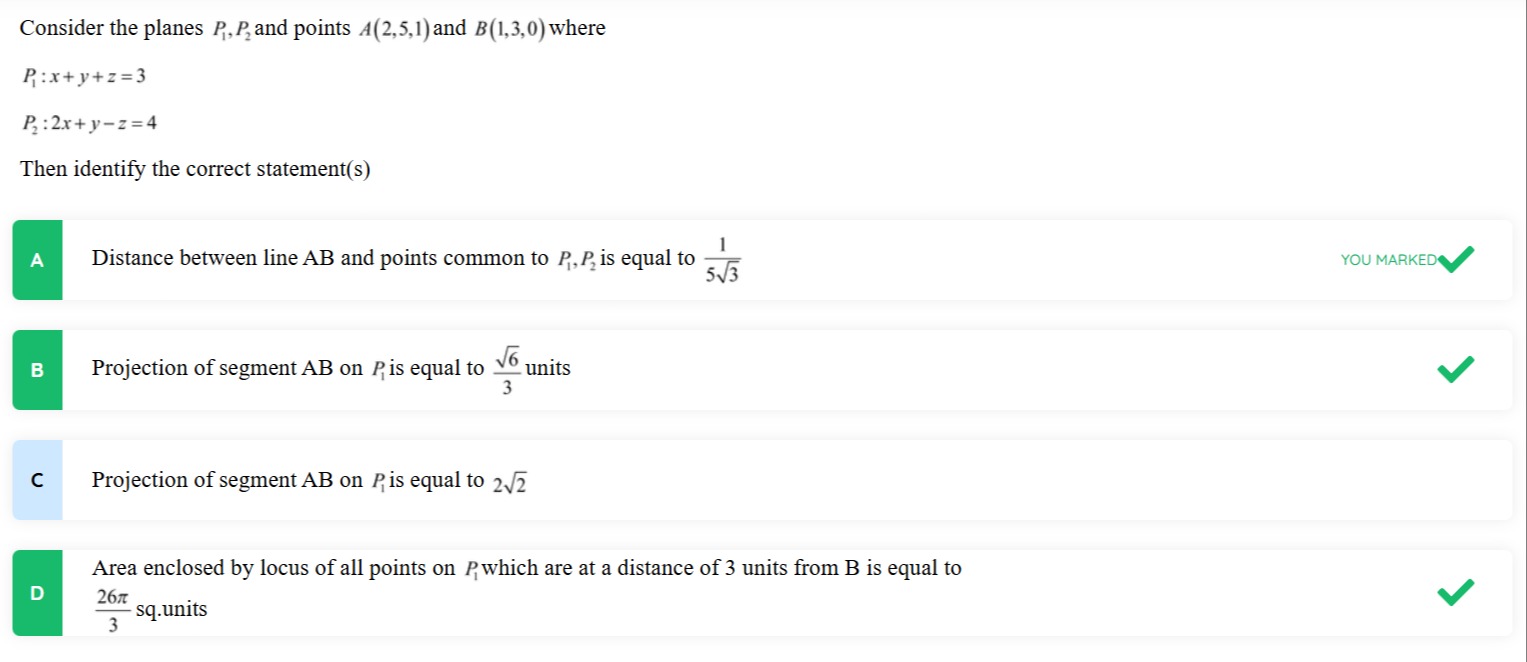Question
Question: Consider the planes $P_1, P_2$ and points $A(2,5,1)$ and $B(1,3,0)$ where $P_1: x+y+z=3$ $P_2: 2x+...
Consider the planes P1,P2 and points A(2,5,1) and B(1,3,0) where
P1:x+y+z=3
P2:2x+y−z=4
Then identify the correct statement(s)

Distance between line AB and points common to P1,P2 is equal to 531
Projection of segment AB on P1 is equal to 36 units
Projection of segment AB on P1 is equal to 22
Area enclosed by locus of all points on P1 which are at a distance of 3 units from B is equal to 326π sq.units
A, B, D
Solution
The problem asks us to evaluate four statements regarding two planes P1:x+y+z=3, P2:2x+y−z=4 and two points A(2,5,1), B(1,3,0).
Statement A: Distance between line AB and points common to P1,P2.
The points common to P1 and P2 form a line, which is the intersection of the two planes. The normal vectors are n1=(1,1,1) and n2=(2,1,−1). The direction vector of the intersection line L is vL=n1×n2=(−2,3,−1).
To find a point on L, we solve x+y+z=3 and 2x+y−z=4. Adding the equations gives 3x+2y=7. Let y=2, then 3x=3, x=1. Substituting into x+y+z=3, 1+2+z=3, so z=0. Thus, C(1,2,0) is a point on L. The line L can be represented as rL(t)=(1,2,0)+t(−2,3,−1).
The line AB passes through A(2,5,1) and has direction vector vAB=B−A=(1−2,3−5,0−1)=(−1,−2,−1). The line AB can be represented as rAB(s)=(2,5,1)+s(−1,−2,−1).
The distance between two skew lines r1=a1+tv1 and r2=a2+sv2 is d=∣∣v1×v2∣∣∣(a2−a1)⋅(v1×v2)∣.
Here, a1=C(1,2,0), v1=vL=(−2,3,−1), a2=A(2,5,1), v2=vAB=(−1,−2,−1).
a2−a1=(2−1,5−2,1−0)=(1,3,1).
v1×v2=(−2,3,−1)×(−1,−2,−1)=i−2−1j3−2k−1−1=i(−3−2)−j(2−1)+k(4+3)=(−5,−1,7).
∣∣v1×v2∣∣=(−5)2+(−1)2+72=25+1+49=75=53.
(a2−a1)⋅(v1×v2)=(1,3,1)⋅(−5,−1,7)=1(−5)+3(−1)+1(7)=−5−3+7=−1.
The distance is d=53∣−1∣=531. Statement A is correct.
Statement B and C: Projection of segment AB on P1.
The length of the projection of segment AB on plane P1 is ∣∣AB∣∣cosθ, where θ is the angle between AB and P1. The angle between vector v and plane with normal n satisfies sinθ=∣∣v∣∣∣∣n∣∣∣v⋅n∣.
AB=(−1,−2,−1), ∣∣AB∣∣=(−1)2+(−2)2+(−1)2=6.
Normal to P1 is n1=(1,1,1), ∣∣n1∣∣=12+12+12=3.
AB⋅n1=(−1)(1)+(−2)(1)+(−1)(1)=−4.
sinθ=63∣−4∣=184=324=322.
cos2θ=1−sin2θ=1−(322)2=1−98=91. Since 0≤θ≤90∘, cosθ=91=31.
Length of projection =∣∣AB∣∣cosθ=6⋅31=36.
Statement B is correct, and Statement C is incorrect.
Statement D: Area enclosed by locus of all points on P1 which are at a distance of 3 units from B.
The locus of points at a distance of 3 units from B is a sphere centered at B(1,3,0) with radius R=3. The equation is (x−1)2+(y−3)2+z2=9.
The locus of points on P1 at a distance of 3 units from B is the intersection of this sphere and the plane P1:x+y+z=3.
The intersection is a circle if the distance from the center of the sphere B to the plane P1 is less than the radius R.
Distance from B(1,3,0) to P1:x+y+z−3=0 is d=12+12+12∣1(1)+1(3)+1(0)−3∣=3∣1+3−3∣=31.
Since d=31<R=3, the intersection is a circle.
The radius of this circle, r, is given by r2=R2−d2=32−(31)2=9−31=327−1=326.
The radius of the circle is r=326.
The area enclosed by this circle is Area=πr2=π(326)=326π.
Statement D is correct.
The correct statements are A, B, and D.
